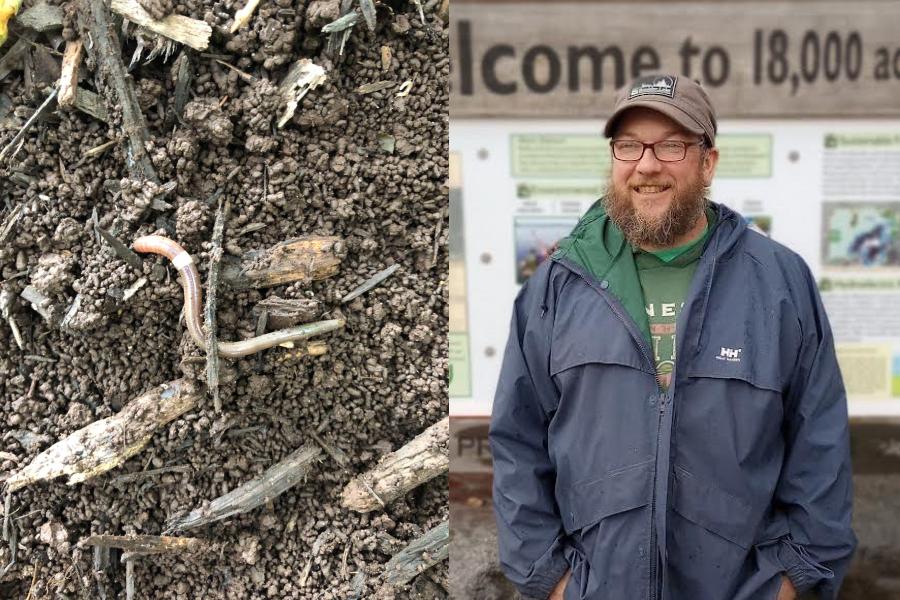
MINNEAPOLIS/ST. PAUL (05/10/2022) — The highly invasive jumping worm, which can damage soil and gardens, has spread across several Midwestern states, including Minnesota.
As the weather warms up and people return to outdoor hobbies like gardening and fishing, Minnesotans should keep an eye out for the species, which can hide in the composting worms or new mulch gardeners use, or spread when anglers unknowingly purchase bait mixed with jumping worms and don’t follow proper disposal practices.
Ryan Hueffmeier, U of M Duluth professor and program director of the Boulder Lake Environmental Learning Center, provides expert comment on how to spot jumping worms and the steps you can take to help prevent the spread of the invasive species. A portion of his research on jumping worms is funded by the Minnesota Invasive Terrestrial Plants and Pests Center.
Ryan Hueffmeier
“Jumping worms are earthworms that look and act a little different than the European earthworms we have grown up with. These worms live in the top six inches of soil and are voracious eaters of organic materials. Through their feeding and burrowing behaviors, they turn the topsoil into loose granular soil that can be easily eroded and does not support plant life well. Because of their ability to clone themselves, just one jumping worm can start a population, which makes them a difficult species to manage.
To date, jumping worms have been documented in the southeast portion of Minnesota up through the metro area and as far north as the St. Cloud area. To learn more about where they have been found visit the EDDMapS jumping worm website.
Jumping worms move less like a worm and more like a snake. They forcefully thrash around when disturbed. They have setae, or tiny hairs, that cover each segment entirely, unlike European earthworms that have only eight setae around each segment. Jumping worms can shed their tail when disturbed and the severed tail will keep wiggling as the worms move away from danger. If you are having trouble identifying the species based on appearance alone, take a look at your soil, which will look noticeably different if invasive jumping worms are present. The way these worms move their bodies in soil makes it a coffee ground texture that washes away easily.
The best thing you can do about any invasive species is to not introduce it somewhere new in the first place. You can lower your risk of introducing jumping worms by finding out where your garden and landscape materials are coming from. Is that company aware of jumping worms and their potential negative environmental impacts? Visually inspect all materials you purchase before they get to your home. When you purchase or exchange plants or other gardening materials, consider putting all of those things into a secondary container and waiting a week before you plant. That way, you will have more time to thoroughly observe the material to spot earthworms. If you do, look for the characteristics of the earthworms to decipher whether they are European earthworms or invasive jumping worms. If you use live earthworms to fish, be sure to throw whatever bait you don’t use in the trash. Once they are introduced to an environment, it is too late.
To find out more about jumping worms, visit the University of Minnesota Jumping Worms Project webpage.”
Ryan Hueffmeier is a research, outreach and education specialist with active projects in forest and landscape ecology and invasive species. For the past 15 years, he has been part of the Great Lakes Worm Watch and the Jumping Worms projects. Hueffmeier is the program director of the Boulder Lake Environmental Learning Center and a professor at the University of Minnesota Duluth where he works towards the transfer of scientific knowledge from evidence-based research to the public through creating accessible outreach programs. The Boulder Lake Environmental Learning Center provides educational programming related to natural resources management practices.
-30-
About the Minnesota Invasive Terrestrial Plants and Pests Center
The Minnesota Invasive Terrestrial Plants and Pests Center (MITPPC) was founded in 2015 by the Minnesota Legislature to research the prevention, detection and control of terrestrial (land-based) invasive species. MITPPC researchers use transformative science to prevent and minimize the threats posed by land-based invasive plants, pathogens and pests. MITPPC is the only research center of its kind in the country, and the center's work to protect the state's native prairies, forests, wetlands and agricultural resources benefits all of Minnesota and beyond. Funding for MITPPC is provided by the Minnesota Environment and Natural Resources Trust Fund as recommended by the Legislative-Citizen Commission on Minnesota Resources (LCCMR). Learn more at mitppc.umn.edu.
About Boulder Lake Environmental Learning Center
Boulder Lake Environmental Learning Center provides comprehensive educational programming that contributes to increased understanding and appreciation of natural resources management practices through the Boulder Lake Management Area. This provides an interpretive window to showcase resources management, including hydroelectric power generation and a working forest environment. The programming also illustrates the many social, biological and economic benefits of the forest.
About “Expert Alert”
University of Minnesota experts can provide commentary, insights and opinions on various news topics. Find selected experts on the University’s Experts Guide or send requests to [email protected].
- Categories:
- Agriculture and Environment





